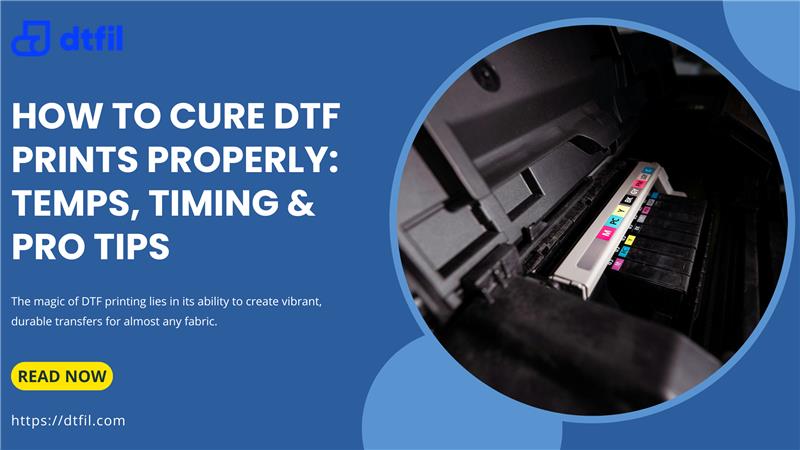In the ever-changing world of custom apparel, Direct-to-Film (DTF) transfers have been becoming increasingly popular in recent years. This creative form of printing, enables realistic images to be transferred (imprinted) onto different types of fabrics using an iron or heat press.
If you are thinking to master the art of transferring these prints onto your chosen garments, this blog will guide you on how to do DTF transfers and how to print to DTF transfers providing DTF printing instructions and DTF process to achieve the best results every time.
What are DTF Transfers?
DTF transfers means direct to film transfers which involves printing designs onto the film that is then transferred into the garments using heat and pressure. These designs are printed in the reversed form on the film and can be easily transferred to other fabrics such as cotton, polyester, blends, and even dark ones.
Apart from traditional methods, the DTF printing process uses new digital printing technology that allows for high-resolution images. Moreover, these transfers are ideal for customizing t-shirts, hoodies, hats and many more with logos, artworks and designs.
Also Read: What is UV DTF Transfers?
How to do DTF Transfers?
Having the right equipment to print DTF transfer is essential. You will need a DTF printer, special DTF ink, adhesive powder, DTF transfer film and heat press or iron. Once you have gathered these tools, let’s follow the steps below on how to create DTF transfers.

Step 1: Get your workspace ready
A well-ventilated and adequate lightning workspace is crucial for optimal printing quality and to avoid the buildup of fumes from the transfer process. Keep your workspace tidy and organized to avoid mistakes and ensure efficient workflow.
And, make sure your heat press machine is working well for the transfer material you can use.
Also Read: How Much is a DTF Printer? Exploring Price vs. Performance
Step 2: Edit your design
Start creating your design for your garment by using certain graphic software tools like Adobe Illustrator, Photoshop, or CorelDRAW. Ensure to adjust the position and size of the image to attain a perfect design.
Do not use the low-resolution images that may affect the pixels of the image when enlarged.
Step 3: Print the design
To learn how to apply DTF transfers, start by using your DTF transfer printer to print the design onto the DTF transfer film. Ensure that your printer is set up to print for DTF as DTF requires a specific print profile.
Moreover, double check the image is printed in a mirror format so that it will print correctly over the fabric.
Step 4: Use the adhesive powder
While the ink is still sticky, you have to spread the hot melt adhesive powder evenly on top of the printed design. If there is excessive powder, then you can flick the image to eliminate the powder from the film.
This powder helps the design stick to the fabric by adhering to the ink and gluing it to the powder. Ensure that the powder completely covers your design.
Also Read: DTF Care Instructions: Washing, Pressing, and Temp/Time Guidelines
Step 5: Cure the design
In this step, locate the film with the powdered design under a heat source such as a heat press or iron for a few seconds to melt the powder slightly. It ensures that the design film is ready to transfer.
Allow sufficient curing time and let it cool to make sure the ink bonds thoroughly.
Step 6: Transfer the design
After your DTF transfer cures, you can proceed with your film over the fabric that you have selected. Make sure that the transfer is aligned perfectly. Preheat the heat press to 300-315 degrees Fahrenheit for 10-13 seconds.
This step should be done properly to ensure the design is imprinted firmly.
Step 7: Peel off the film
To learn how to make DTF transfers, peel off the transfer from one side when it gets cool. If any areas are not fully transferred, press them again with a protective sheet.
Then, the transfer should be properly glued to the garment so that the fine detailing remains.
Do you Need to Cut DTF Transfer?
This popular printing method helps to custom design various materials. However, before applying the transfer to your clothes, it is necessary to cut the excess film away from the design.
By eliminating these excess films, you can promote better stickiness between the transfer and the fabric resulting in a more durable and long-lasting finish. A neatly cut transfer helps to raise the overall attractive appeal of the final product that makes it more visually pleasing.
Also Read: DTF vs Sublimation & Other Printing Methods
Conclusion
With this guide, you have understood the methods on how to do DTF transfers onto your apparel to turn your personalized designs into real life. Whether you are printing for small business or printing for fun, mastering DTF transfers can help you unlock endless innovative possibilities.
If you're looking to explore more about DTF transfers, we've got you everything you need. It offers a versatile and high-quality solution for printing designs directly onto fabric. Visit DTF IL to start your journey today and take your designs to the next level!
FAQ’s
What do I need to do to make my own DTF transfers?
Ans. To make your own DTF transfers you need to prepare designs using graphic design software and print them onto DTF print using DTF transfers. Add DTF powder, cure the film, and then apply the transfer to your garment using a heat press.
What printer do I need to make DTF transfers?
Ans. To make DTF transfers, you need a specialized inkjet printer designed for DTF printing, capable of handling DTF ink and paper thickness, and offering high resolution and color accuracy.
How are DTF transfers made?
Ans. A DTF transfer is made by printing a design directly onto a film using DTF printing techniques, which involves layering sublimation ink, heat, and pressure to merge the image onto the film, allowing for a durable and versatile transfer that can be applied to various fabrics.
What is needed to make DTF transfers?
Ans. To make DTF transfers, you need a DTF printer, DTF ink, DTF film, adhesive powder, a heat press or iron, and a garment, along with design software and a computer for printing and cutting the film.
How to apply DTF transfers at home?
Ans. Preheat your heat press to the recommended temperature, place the transfer on the garment with the printed side facing down and apply heat and pressure for the specified time, ensuring proper alignment and using a placement tool set if necessary.
How do you print a DTF transfer?
Ans. Print the design onto a specialized film in reverse, then apply the film to the garment using a heat press for 15 seconds and quickly peel back the film while still warm.








